
Zinnia: sowing, planting and care
Contents
Zinnia in a nutshell
- Zinnia is an annual plant with a long flowering period throughout summer until first frosts
- Single or pompon flowers are available in a great diversity of vivid or pastel colours, sometimes striking, sometimes subtle
- Particularly hardy and easy to grow, it is a reliable choice for the garden
- It is grown in full sun in any rich, well-drained soil
- Versatile, it has its place in borders, beds or summer containers but also in the vegetable garden, between ranks of vegetables
A word from our expert
Highly appreciated for robustness, brilliant colours and ease of growing, Zinnia is a safe bet in the garden. A pity it isn’t perennial! Zinnia is one of those annual plants that are foolproof, finding a place in every garden, whatever its style!
Unjustly overlooked because of its somewhat hardy, rough appearance, zinnia nevertheless ranks among the champions of flower abundance.
Endowed with charm of wild plants, it produces radiant flowers from June to first frosts in every corner of the garden.
Zinnia has iron health, requiring only a warm, sunny position.
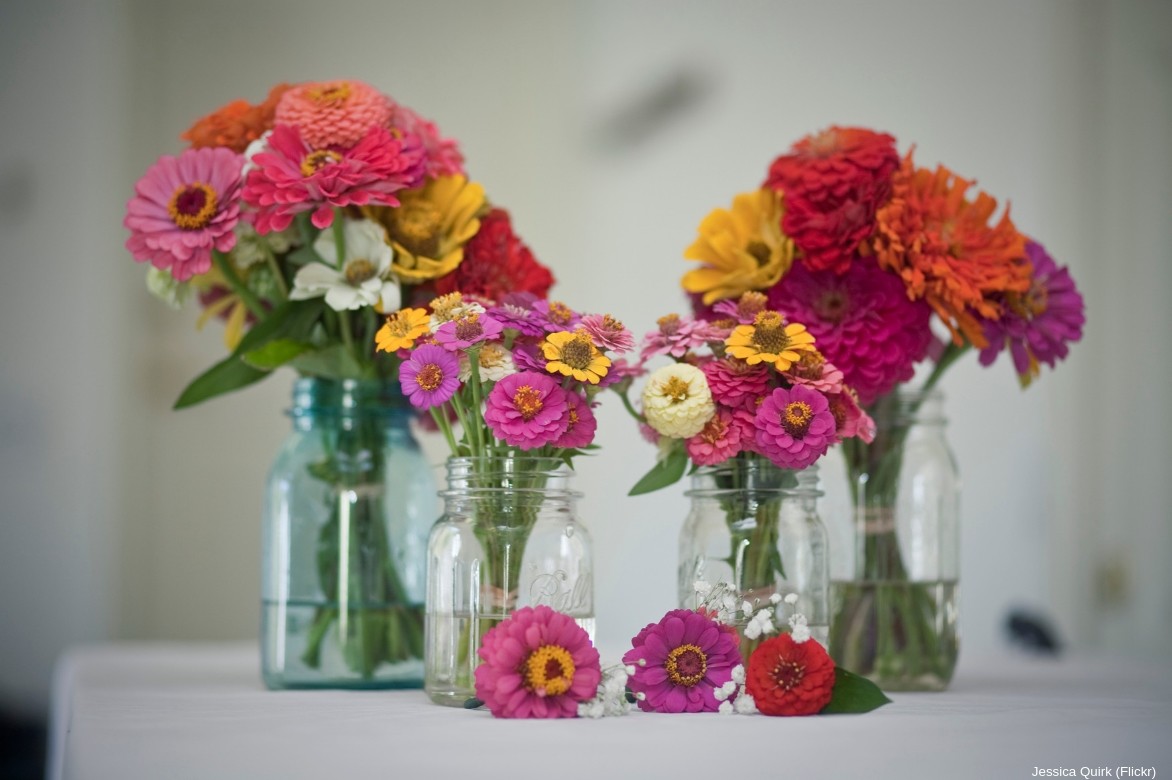
From Zinnia elegans, the most common, to Zinnia angustifolia and Zinnia acerosa, via the dwarf zinnias of the ‘Profusion’ series or the Zinnia ‘Lilliput’, the giant zinnia or the monstrous-flowered zinnia whose heads exceed 10 cm in diameter, there are over twenty species including numerous hybrids and cultivars. All are superb in beds, in borders, in vegetable gardens and also in pots.
Outstanding in garden or as a cut flower, discover our zinnias in plug plants or our unique collection of zinnia seeds and don’t hesitate to grow it almost anywhere!
And be tempted right away by our new flower seeds!
Description and botany
Botanical data
- Latin name Zinnia
- Family Asteraceae
- Common name Zinnia
- Flowering from June to autumn
- Height 0.15 to 1 m
- Exposure sun
- Soil type all, well-drained
- Hardiness frost-tender
Native to scrub and desert meadows from southern United States to Mexico, the Zinnia is an herbaceous annual of the family Asteraceae closely related to daisies and cosmos.
It is a non-hardy plant grown in gardens as an annual flower because of its frost-tender character.
Genus comprises 20 species, the most common and long-known being Zinnia elegans or Elegant Zinnia. Zinnia tenuifolia, a botanical species, and Zinnia angustifolia or Mexican Zinnia are more unusual. There are nearly a hundred hybrids in varieties in a wide range of colours, pastel or bright. They also differ in height (dwarf zinnias, tall zinnias), and in diameter and shape of their single, semi-double or very double flowers.
With fairly rapid growth, Zinnia forms a vigorous, ramified, bushy and compact clump, taller or shorter according to variety. Dwarf varieties do not exceed 0.2 m while tall zinnias can reach 0.9 m to 1 m in height.
From this bushy, erect stump emerge rigid stems, angled or rounded and well ramified bearing rough, slightly downy foliage of a pleasant medium to pale green. Opposite, linear, ovate or elliptical leaves measure 2 to 8 cm and are pointed.
With its pubescent texture, this deciduous foliage provides a backdrop to Zinnia’s floriferous flowering, which begins in June and continues until first frosts.
Flowers are solitary heads borne at end of long upright stems. Zinnia flower has a very strong personality. These solitary head inflorescences are formed of one or several rows of ligulate ray florets radiating around a centre that releases tiny tubular florets with pistils more or less visible.

Some zinnia flowers: Zinnia ‘Queen Red Lime’, Zinnia ‘Profusion Double White’, Zinnia elegans ‘Mazurkia’, Zinnia peruviana, Zinnia ‘Double Zahara Raspberry’
Flower diameter ranges from 2 cm to 12 cm. Structure, sometimes complex, also varies by variety; single, semi-double or pompon very double. Shape of ligules also differs by cultivar: spatulate, more or less tubular, or flat.
Some zinnias bear long rolled and pointed petals forming a pompon-like centre <strong;resembling a cactus flower, others present only a single crown of petals around a central disk like a simple daisy or a cosmos, others take the form of slightly flattened pompons evoking small dahlias.
Accordingly, zinnia flowers are classified: cactus-flowered zinnias, dahlia-flowered, scabious-flowered, chrysanthemum-flowered…
Zinnia is much appreciated for its dazzling, sometimes even exuberant colours. Flowers display very diverse hues, pastel or vivid, uniform or surprising bicolours. They come in an endless palette from flaming orange to cherry red, pure white to golden yellow, purple to smoky pink, including the chartreuse green of Zinnia ‘Envy’.

Zinnia elegans ‘Envy Double’ in a lovely chartreuse green
Slightly scented, flowers give off a waxy scent reminiscent of floor polish, and they also hold up very well in summer bouquets.
Nectariferous, this abundant flowering delights bees and butterflies.
Vigorous and floriferous, the Zinnia is within reach of all gardeners. It dislikes coolness and shade and thrives in sun in a warm position, in all ordinary, well-drained soil. Versatile, it is planted in borders, in beds where it creates splashes of colour or in the vegetable garden between vegetable rows. It can also be grown in pots to flower a terrace in summer.
Main species and varieties
Around twenty annual species of zinnias are recognised, the most common being Zinnia elegans, which has given rise to numerous cultivars. There are also many hybrid species of zinnias arranged in series such as ‘Profusion’ and ‘Lilliput’. They differ in size (dwarf zinnias, giant zinnias), flower diameter and shape.
All offer abundant flowering from June until the first frosts.
Our zinnias are offered as plug plants or as seeds in a wide range of bright, vivid colours, from the most muted to the most vibrant, often in mixed varieties.
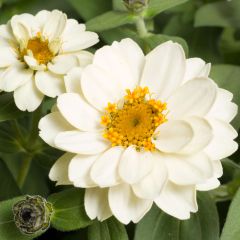
Zinnia Zahara Double White
- Flowering time August to December
- Height at maturity 40 cm
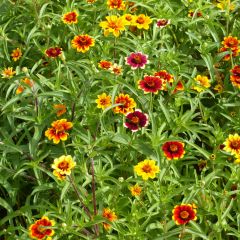
Zinnia Persian Carpet Seeds
- Flowering time August to October
- Height at maturity 35 cm
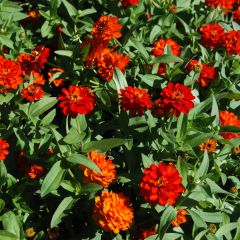
Zinnia zahara Double Fire
- Flowering time August to December
- Height at maturity 35 cm
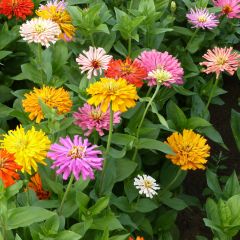
Zinnia elegans Burpeeana Chrysanthemum Flowered Mixed Seeds
- Flowering time August to November
- Height at maturity 90 cm
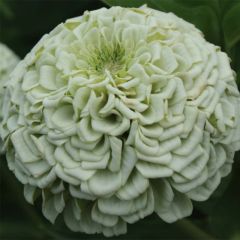
Zinnia elegans Polar Bear Seeds
- Flowering time August to November
- Height at maturity 75 cm
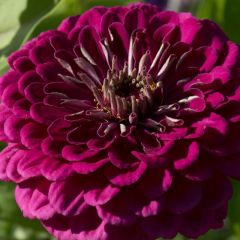
Zinnia elegans Purple Prince Seeds
- Flowering time August to November
- Height at maturity 75 cm
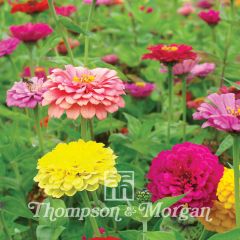
Zinnia elegans Giant Double Mixed Seeds
- Flowering time July to September
- Height at maturity 75 cm

Zinnia tenuifolia Red Spider Seeds
- Flowering time August to November
- Height at maturity 60 cm
Discover other Zinnia seeds
View all →Available in 1 sizes
Available in 1 sizes
Available in 1 sizes
Available in 1 sizes
Available in 1 sizes
Available in 1 sizes
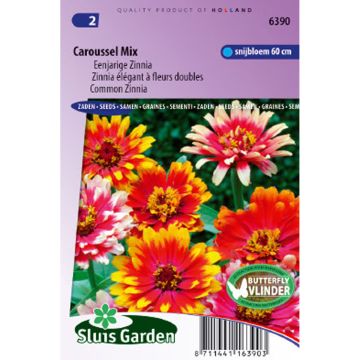
Available in 1 sizes
Available in 1 sizes
Available in 1 sizes
Available in 1 sizes
Planting zinnias
Where to plant zinnia?
Frost-tender, Zinnia does not survive winter in our climates. That is why it is grown as an annual in our gardens. It is born and dies within the same year, yet still has time to enchant gardens with its endless flowering!
Easy to grow, Zinnia will be happy and floriferous only in a warm, very sunny position, showing tolerance to summer drought. It thrives in regions with hot, torrid summers but can be more capricious in areas with cool or excessively rainy summers; it dislikes cool conditions, shade and prolonged wet periods.
Although it adapts to any good garden soil, even gravelly, it will be more vigorous in fertile, humus-rich, well-drained soil.
This is a very versatile annual plant that stands out in informal beds, even in unproductive or neglected areas of the garden. Dwarf zinnias are perfect for colouring regular borders, forming carpets of flowers in very sunny rockeries up to the onset of winter, or blooming in pots on the terrace in summer. Tall zinnias tuck in in the centre or back of beds or remain neatly in rows in the vegetable garden.
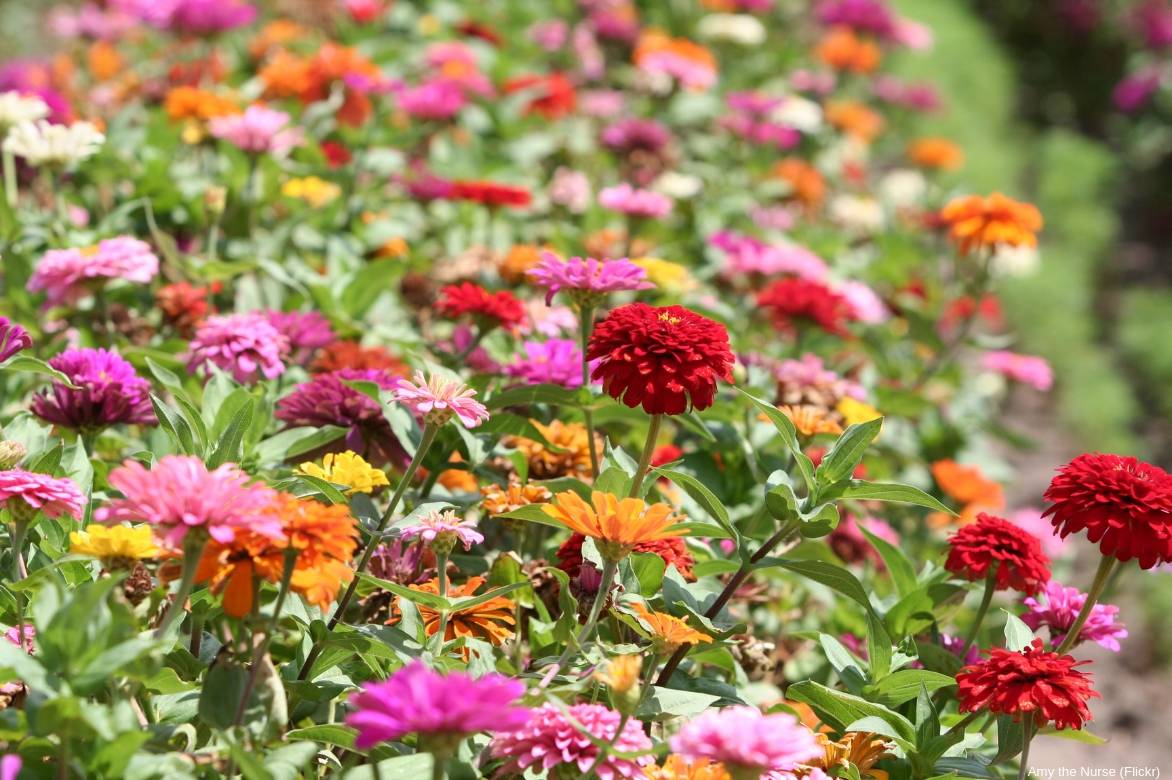
When to plant zinnias?
Planting Zinnia plug plants is done from March to May when frosts are no longer expected.
How to plant zinnias?
In open ground
Pot up Zinnia plug plants on receipt and keep them under cover in a warm, bright place at a temperature above 14 °C for a few weeks. Wait until mid-May before planting them out in open ground.
Plant in groups at a rate of 5 buckets per m2, respecting spacing of 35 to 40 cm for tall varieties and 25 cm for dwarf zinnias.
- Dig over soil well to loosen it
- Dig a hole 2–3 times wider than the plug plant
- Spread gravel or clay pebbles at the bottom of the planting hole
- Place the plug plant in the centre of the hole, collar at soil level
- Backfill with garden soil mixed with potting compost for flowering plants
- Firm down with foot
- Water generously
- Mulch around the base of the zinnia to keep soil cool
More tips on how to plant our annual plug plants on our blog!
Planting zinnia in pots
Zinnia does very well in pots, planters or tubs placed in full sun.
- Make a good layer of gravel or clay pebbles at the bottom of the pot
- Set the plug plant into good potting compost for flowering plants
- Water generously after planting
When and how to sow zinnias?
Succeed in sowing zinnias under cover
Zinnia is a tender plant that must be sown from March to April under warm cover at a minimum temperature of 15°C. Pot on young plants in April, May, even June depending on region. Discover our tips and tricks to succeed in sowing annual seeds on our blog!
- Sow zinnia seeds in seed tray in good seed compost
- Cover seeds lightly with compost kept slightly moist
- Maintain 15-25°C during germination
- When young plants reach 3 leaves, pot on into buckets
- Plant young plants in garden once risk of frost has passed and when outdoor temperature is above 18°C
- Space plants about 30 cm apart
- Water to ensure establishment
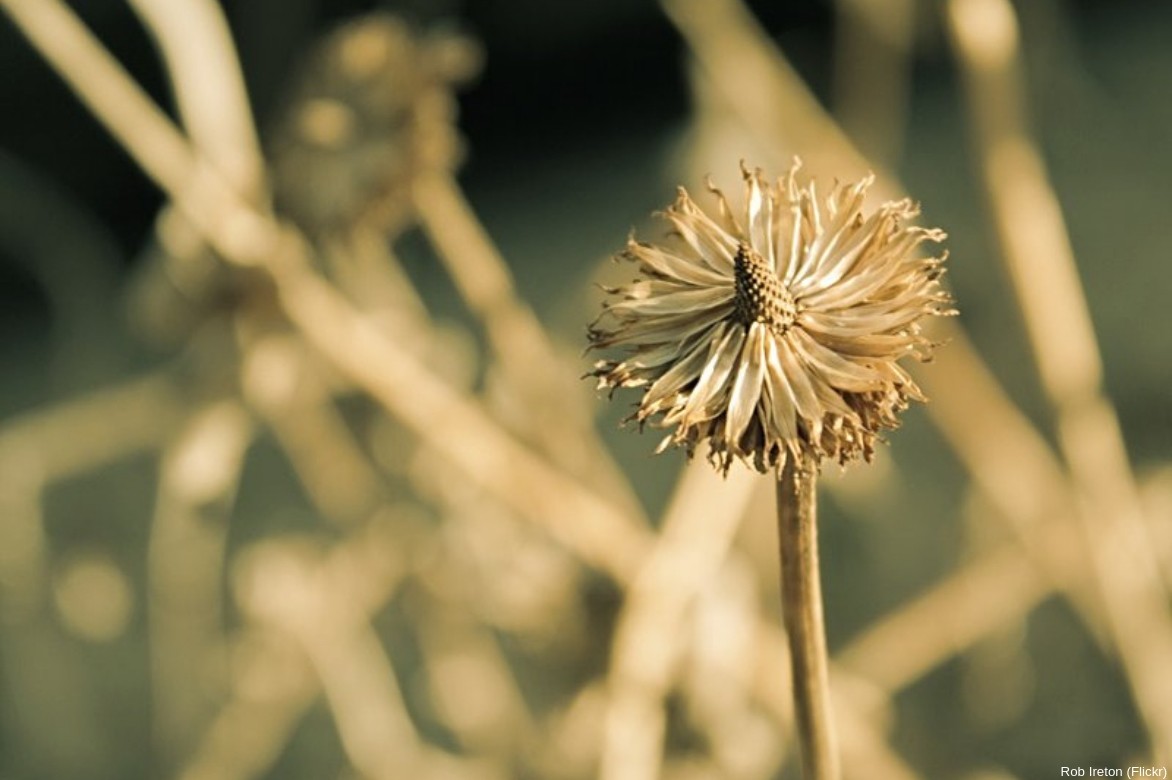
Withered zinnia flower
In open ground
Think about staggering sowings for longer flowering.
- After frosts, in May in well-drained, warmed soil, sow thinly by hand without burying seeds too deep: cover them barely with 3 mm of compost
- Keep soil moist until seeds germinate
- After emergence, between 7 and 14 days, thin ranks leaving about 30 cm between each young plant
Care and maintenance
Le Zinnia is truly a carefree annual plant, easy to grow and maintain.
Its water needs are fairly low. However, in periods of high heat, do not skimp on regular watering at the base of the plant and not on the foliage: Zinnia is susceptible to powdery mildew. Mulch in June to keep its roots cool.
Water potted zinnias more regularly as soon as soil surface is dry and apply fertiliser for flowering plants to support flowering.
Cut off faded flowers from zinnias to encourage new flowers and extend flowering.
Pinch the main stem as flowering starts to encourage branching.
Remove all plants before severe frosts.
Possible diseases and pests
The Zinnia is quite hardy, but is often susceptible to powdery mildew. Water at the base of the plant never wetting the foliage.
Discover our solutions to prevent powdery mildew.
Slugs are also very fond of young shoots; see our tips for controlling these pests.

Slug damage on zinnias
Propagation
Zinnia is propagated exclusively by sowing (see above “when and how to sow zinnia seeds“). If you have collected and stored zinnia seeds from your dried flowers, you can sow them the following year. Be aware, however, that it is very likely you will not get the same flowers as the parent plant. Indeed, zinnias symbolise inconstancy, and this is due to genetics (Mendelian inheritance) as well as cross-pollination. Thus, from one generation to the next, flowers can be totally different if you harvest your own seeds. Otherwise, make your choice from our unique annual zinnia seeds.
Zinnias companion planting in the garden
The Zinnia is a bright annual plant with colours sometimes very vivid, verging on garish, that naturally stands out in natural and naturalistic gardens and country gardens. It is equally appreciated planted in a mixed border or at the front of a border and in the vegetable garden among young vegetable plants. Depending on variety, it will bring either a fresh, tidy touch or a warm, exuberant note to summer scenes and pairs easily with many annuals or perennials with summer flowering.

A romantic, country-style combination idea: pink Zinnia such as ‘Miss Willmott’, ‘Art Deco’ or ‘Double Zahara Strawberry’, Hordeum jubatum and white umbels of Daucus carota (or pink umbels with ‘Dara’)
In the foreground of a mixed border, it pairs happily with coleus, Lonas annua, snapdragons and wallflowers, all equally easy to grow.
At the heart of a colourful bed, mix tall zinnias with dahlias, chrysanthemums, blanket flowers, bidens, coreopsis, Rudbeckias, coneflowers for flowering until first frosts, and contrast foliage of sedges.
In a large sunny parterre, combine zinnias with Salvia farinacea, Eryngium and Verbenas bonariensis.
Tone down the colours of the boldest varieties by pairing them with other annual plants in softer shades, such as love-in-a-mist, tobaccos, cosmos, ornamental carrot, white gauras or Ammi majus, placing them in small touches amid grey or contrasting foliage of wormwoods or sedges.
Zinnia flowers will also impose themselves easily in a Catalan-inspired bed in warm tones with coneflowers, Cannas, tritomas, achilleas, bidens and blanket flowers. Lightweight grasses such as Stipa tenuifolia, Miscanthus or Eragrostis trichoides will calm the blaze and add softness to counterpoint the slightly rigid habit of this annual.

An example of a warm-toned combination: red Zinnia (‘Profusion Double Hot Cherry’, ‘Profusion Double Fire’), Canna (e.g. ‘Durban’), Hemerocallis ‘Citrina’, Dahlia ‘Catherine Deneuve’ and you can complete with Iberis ‘Absolutely Amethyst’, Salvia farinacea ‘Victoria’ and red annual verbenas
In the vegetable garden, a few rows of zinnias will mingle with panicle-forming amaranths, purple beetroot, colourful cardoons and chard leaves of Swiss chard, marigolds, dahlias and nasturtiums.
In containers, pair zinnia flowers with petunias and surfinias.
Useful resources
- Available as plug plants or seeds, discover our annual flowers!
- Add zinnias to a colourful mixed border or vegetable garden where they will attract pollinators!
- Low-maintenance and in flower for nearly six months, zinnias are a must in a country garden
- Discover our 7 ideas for creating beautiful summer planters
- Subscribe!
- Contents
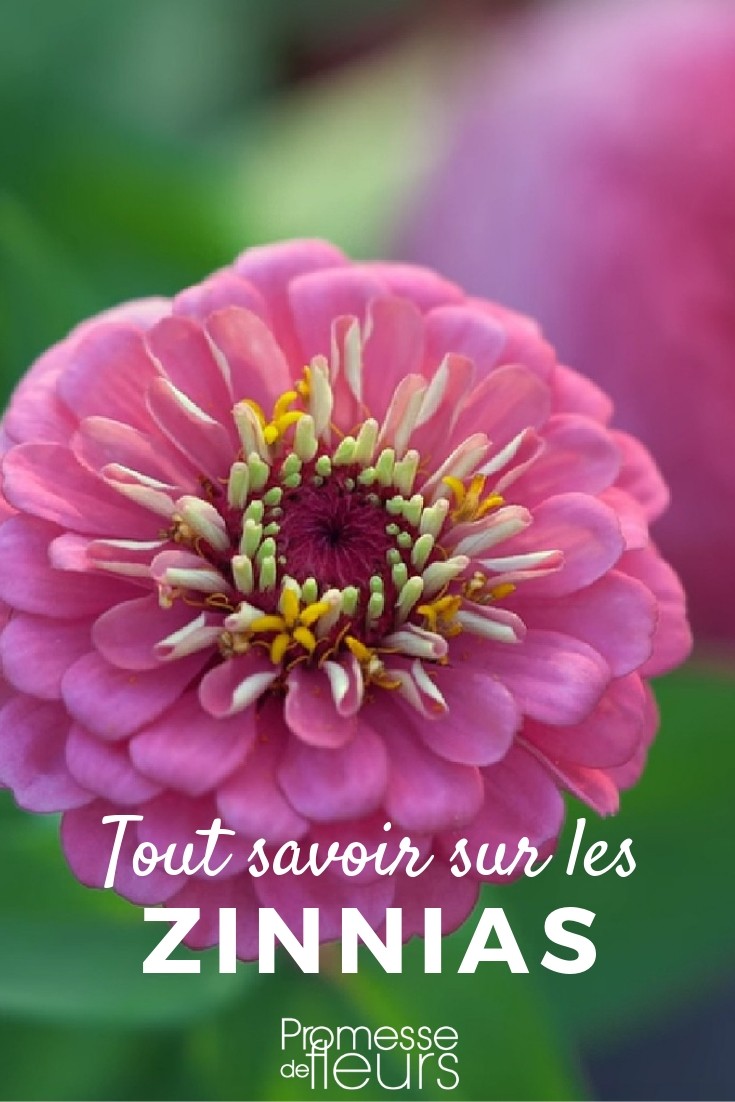































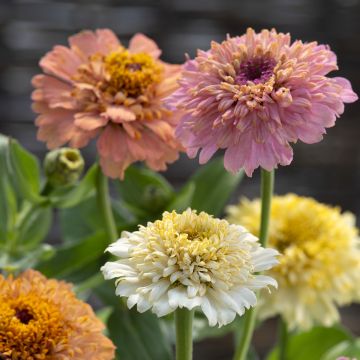
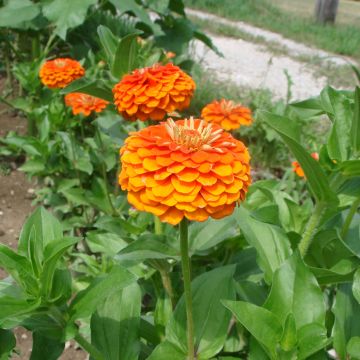

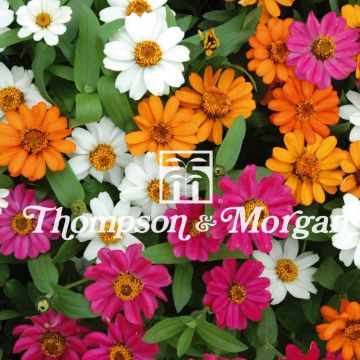

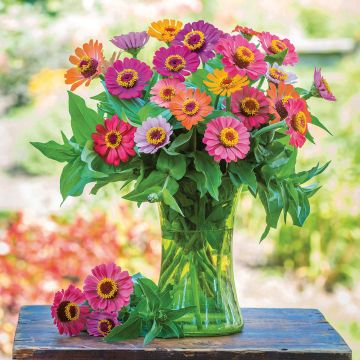
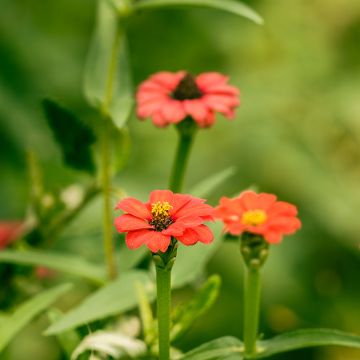
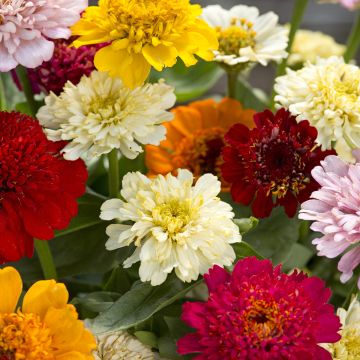

Comments